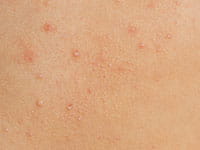What is Molluscum?

The molluscum virus is spread from the skin of one person to another. Close, direct contact is usually necessary to spread the virus, but it can be spread from shared towels or bathing with an infected person. Some experts believe that molluscum may also be spread in swimming pools. Scratching the bumps may also cause them to spread.
Symptoms
- Molluscum looks like shiny, small bumps that may be skin-colored, white or pink in color. Sometimes you can see a white “pit” in the center.
- Molluscum is often found in clusters on the skin of the chest, abdomen, legs, groin and buttocks. Molluscum can also involve the face and eyelids.
- A person may have anywhere from a few to a hundred or more mollusca. When molluscum is starting to go away, it usually becomes pinker in color. Eczema may develop around the molluscum. Sometimes the molluscum turns red and gets larger in size right before going away.
- A bacterial skin infection may sometimes occur in the areas affected with molluscum, but this is uncommon. Children with eczema may develop more severe and widespread molluscum, and the infection may take longer to resolve.
Treatment
Usually molluscum goes away on its own within 12-15 months, although it may last as long as two to three years. In general, no treatment is required, and scarring is very rare, although tiny “pits” may be seen in the skin after the molluscum goes away; these usually fade. Once resolved, it is very unusual for a child to become infected with molluscum again.
If possible, keep infected areas covered with clothing while your child is at school and when they are playing in close contact with other children. This may help to reduce the chance of other children becoming infected. You do not need to cover the infected areas with bandages.
Treatment of one or more mollusca does not prevent new molluscum from appearing. Common treatments include:
- “Freezing” the molluscum
- Applying a medicine that causes the skin to blister
- Applying a topical medicine to irritate the molluscum to get the immune system to recognize and fight them off.
Scraping (curetting) molluscum is not generally recommended as this is very painful and can leave significant scarring.
Referral to a Specialist
Most molluscum does not need to be treated or referred to a specialist. Your primary care provider will only refer to a specialist if there is a special concern such as a child with a weakened immune system or severe eczema.



